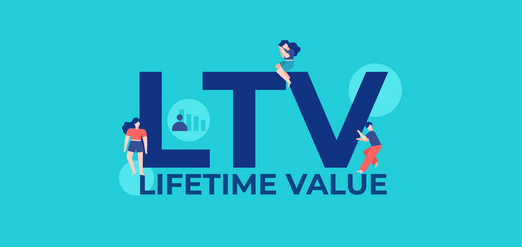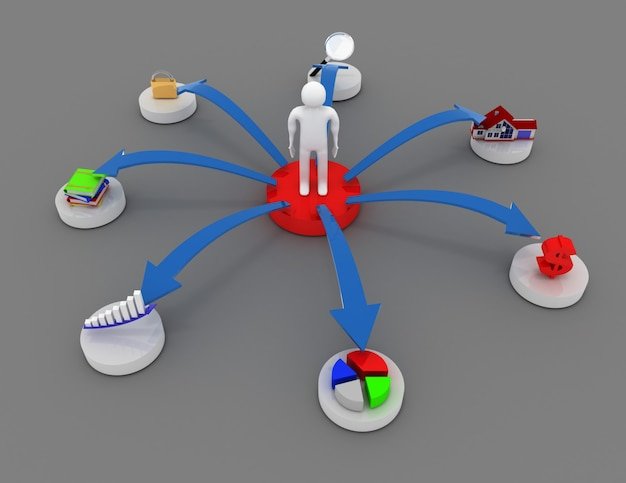How customer segmentation helps achieve business goals
-
Leonid Vlasov
Copywriter Elbuz
You have the perfect product. But do you know who really needs it? How to find those people who will certainly love your product and be willing to pay for it? Today we'll look at one of the most powerful strategies in the marketing world - customer segmentation. You may have already heard about this method, but let's dive into the details together and find out how it can change your business forever. What is customer segmentation? Why is it needed? What benefits does it provide? And, most importantly, what methods and criteria should be used to successfully analyze data and identify buyer groups and market segments? Hold on tight because customer segmentation is the door to new opportunities and success for your business. Are you ready to dive into this exciting world with us? Then continue reading!

Glossary
Customer segmentation: a data-driven process that divides a market audience into groups of similar consumers.
Segmentation Objectives: The main goal of customer segmentation is to improve understanding and interaction with customers, optimize marketing strategies and achieve maximum efficiency in promoting goods or services.
Benefits of segmentation: a segmented approach allows you to personalize communication with customers, tailor products and offer a personalized approach, increases the likelihood success of marketing campaigns and increases customer loyalty.
Segmentation criteria: parameters by which the audience is divided into segments, such as demographic data (age, gender, geography), psychographic data (interests, values, lifestyle), behavioral data (purchase frequency, preferences).
Segmentation methods: a variety of approaches and tools used to identify customer segments, such as cluster analysis, factor analysis analysis, building user personas, machine learning models.
Model 5W: model based on answers to 5 questions: Who, What ), Where (where), When (when), Why (why) and allows you to get a complete picture of customers and their needs.
Khramatrix: a segmentation method based on a matrix of customer characteristics and target market, allows you to identify segments with the largest potential.
Hunt's Ladder: Model based on customer decision stages to identify key customer touchpoints in purchasing process.
Lifetime Value (LTV): an indicator that assesses the value of a customer to a business throughout the entire period of interaction with him , allows you to identify the most valuable segments and concentrate efforts on retaining them.
Action algorithm: sequence of steps that should be followed to conduct successful data analysis and customer segmentation: 1) setting a segmentation goal, 2) selecting segmentation criteria, 3) determining a segmentation method, 4) describing a segment profile, 5) preparing a set of measures.
Segmentation errors: common errors in customer segmentation such as incorrect selection of criteria, insufficient data, incorrect description of segments, ignoring changes in customer behavior.
Customer segmentation is an integral part of a successful marketing strategy. Proper segmentation allows companies large and small to effectively interact with customers, improve the quality of service and increase the likelihood of achieving business goals. Knowing the basic terms and techniques of segmentation will help you more clearly understand and apply this tool in your work, as well as avoid common mistakes.
Buyer segmentation: What it is and why it matters
Clear understanding of the target audience
When it comes to effective selling, a clear understanding of the needs, interests, preferences, problems, fears and objections of our target audience is key. It is this information that will help us create marketing activities that will interest buyers at first glance and keep their attention.
Traditionally, advertising messages focus on the technical characteristics of goods and services. However, successful brands are increasingly taking a different route - they are focusing on the clear benefits that the customer will receive when making a purchase.

Why customer segmentation is needed
This is where customer segmentation comes into play. It helps you explore all the important data needed to formulate targeted marketing activities. Segmentation is a method that allows you to distribute potential buyers into groups with a similar set of characteristics.
What results can businesses achieve by segmenting customers? Here are a few key goals:
- Determining market share and forecasting sales. Segmentation allows you to identify market volumes and opportunities, as well as predict sales volumes in each buyer group.
- Development of effective positioning and sales strategy. By understanding the characteristics of each segment, we can develop an appropriate strategy to best present our products or services.
- Selecting appropriate communication channels. By considering the characteristics of each group, we can determine which communication channels and marketing tools will be most effective in interacting with the target audience.
- Create relevant offers. Segmentation helps us understand the characteristics and needs of each buyer group, which allows us to create offers that precisely meet their expectations.
- Strengthening advertising campaigns. Through segmentation, we can more precisely target our advertising campaigns so that they reach exactly the people who may be interested in our products or services.
- Increasing loyalty of the target audience. By dividing our audience into groups and catering to their individual needs, we can create a personalized experience that builds customer loyalty.
- Increased customer retention rates. Through segmentation, we can determine which customer groups require the most attention and develop retention plans to meet their needs and wants.
- Building high-quality, long-term relationships with customers. To create strong and lasting relationships with customers, you need to know their needs, interests and preferences. Segmentation allows us to understand our audience more deeply and establish quality interactions with them.
Online store "Noon-march"
In order to explain the benefits of customer segmentation, I would like to share my personal story and work experience with the online store "Noon-march". "Noon-march" is a small store specializing in selling fashionable clothes for young people.
When I joined the Noon-march team as a marketer, I was faced with the problem of low conversion on the site. The site had a huge selection of products, but we could not draw the attention of the target audience to our offers.

This is where customer segmentation comes to the rescue. We conducted an in-depth analysis of our customer base and divided our customers into several groups, taking into account their interests, lifestyle, fashion preferences and price category.
As a result, we have developed individual marketing strategies for each buyer group. We have created personalized offers that best suit the needs of each group. We've also tailored our advertising campaigns and communication channels to ensure they're completely on target.
The results were impressive. Our conversion rate increased by 30% and our sales increased by 40%. Thanks to customer segmentation, we began to better understand our audience and offer them exactly what they need.
How to Choose Segmentation Criteria and Methods
When choosing criteria and methods for customer segmentation, it is important to consider the specifics of your niche and the products or services you offer. Let's look at a few typical criteria that can be used in segmentation:
- Demographics such as gender, age, marital status, income and education.
- Geographic information such as place of residence, region, or country.
- Behavioral characteristics, such as lifestyle, hobbies, consumption preferences, Internet behavior.
- Psychographic data related to the personal characteristics and values of buyers.
Remember that you can also combine different criteria for more detailed segmentation. For example, you can combine gender, age, and interests to create segments.
Summary
Customer segmentation is an important tool for business. It helps us better understand the needs and preferences of our audience, which in turn allows us to develop targeted marketing activities and create personalized offers.
Conducting customer segmentation takes time and analytics, but it rewards us with more successful sales, strengthens our relationships with customers, and allows us to better understand their needs.
Don't be afraid to experiment and try different segmentation methods and criteria to find the ones that work best for your business. And remember that only a deep understanding of your target audience will allow you to achieve success.

How I segmented clients: main criteria
When it comes to customer segmentation, there is no one-size-fits-all method. However, I can share my experience and talk about the key criteria that I relied on when analyzing the target audience and creating a client portrait. These criteria will help you identify your audience segments and target your marketing efforts to the most promising customer groups.
Geography: One of the first and most important criteria is the geographic distribution of your audience. Country, region, locality - all these factors can play an important role when choosing segments. For example, if your business is focused on the local market, then it will be useful for you to know which customers are in your region and neighboring cities.
Demographic factors: Gender, age, marital status, profession, income level - all these characteristics can be used to segment customers. They will help you better understand who your target audience is and what needs and preferences they have. For example, if you sell products for children, then segmenting by age and marital status can be very useful.
Behavioral characteristics: Level of willingness to purchase, factors influencing choice, frequency of purchases are all important data that will help you better understand preferences and behavior clients. For example, if your company sells cars, segmenting by income level and purchasing frequency can help you determine which customers are most interested in your product.
Psychographic Traits: Value system, hobbies, attitudes, brand loyalty are all psychographic characteristics that will help you determine which customers are the best fit for your company and product. Sometimes customers may be loyal to your brand not because of the price or quality of the product, but because of shared values and beliefs.
What also helped me when segmenting customers was to consider the competition in the niche. If there is a wide choice for the client, I pay attention to more nuances in order to choose the right segment. All features used in the segmentation process fall into one of four main criteria.
Remember that when developing segmentation, you need to take into account the specifics of your business. It is important to create a detailed and accurate portrait of your target audience to optimize your marketing efforts and achieve greater business success.

By understanding customer interests and needs through segmentation, you can create more effective marketing campaigns, offer personalized solutions, and improve the customer experience. This will allow you to attract new customers, retain existing ones and create loyalty to your brand.
As an example of how I used segmentation in practice, I would like to share with you my experience with online newsletters. Using data about clients' preferences and interests, I created personalized newsletters in which each client received information that was most interesting to him. The results were impressive - openness and sales conversion increased significantly.
Now you know the basic criteria for customer segmentation and how I applied them in practice. Don't be afraid to experiment and identify the most promising segments for your business. Consider the competition in your niche and the basic needs of your customers, and the results will follow.
Summary:
- Customer segmentation helps you better understand your target audience and target your marketing efforts to the most promising client groups.
- Key criteria for segmentation include geography, demographics, behavioral characteristics and psychographics.
- The specifics of the business and competition in the niche should also be taken into account when segmenting customers.
- Using segmentation can lead to more effective marketing campaigns, personalized solutions, and improved customer experiences.
"Personalized marketing campaigns based on customer segmentation can effectively attract new customers and retain existing ones. This is a key factor for business success!" - Boris Osadchiy, marketing specialist at Auchan.
"Customer segmentation is an integral part of any successful marketing plan. Use it to reduce costs and increase the effectiveness of your marketing efforts!" - Evgenia Popova, marketing expert at Epicenter.
Now, based on my experience and advice, I highly recommend that you start segmenting your audience and use this powerful tool to improve the performance of your business.
Have questions or need more information? Leave a comment below and I'll be happy to answer!
Methods for dividing your audience into groups
There are many methods for segmenting your target audience.Next I will talk about the basic tools that are most often used in e-commerce.

The 5W model method, developed by Mark Sherrington, is an almost universal segmentation tool. And its use does not require special knowledge and skills. The main essence of this method is to obtain answers to five main questions:
- What do you sell?
- Who is your customer?
- Why should he buy your product and what problems will it solve?
- Under what circumstances might your product be needed?
- Where will the customer see and purchase your product?
An example of using the 5W method in audience segmentation can be given in the example of a dance studio. The method will allow you to identify the main customer groups and prepare a relevant Unique Selling Proposition (USP) for each segment.

Another interesting method is Khramatrix. It is a more advanced segmentation option that complements the 5W model. The Khramatrix table adds a detailed description of the audience, taking into account geographic and demographic characteristics, behavioral characteristics, level of readiness to purchase, and targeted actions that prompt decision making.
This method allows you to draw details and understand how to work with each segment, what to offer and what advertising to use.
The Hunt Ladder method, developed by marketer Ben Hunt, represents 5 stages of awareness that a consumer goes through from the moment he meets a company to placing an order. This method works for any product and takes into account the different levels of awareness at each stage of interaction. To better illustrate this technique, consider the example of Victoria.
Victoria had an old washing machine that one day broke down. The specialists offered repairs at a fairly high price, and Victoria realized that it would be more profitable to buy a new, more modern model. She began comparing different offers and studying reviews from other buyers. As a result, Victoria made the final choice and completed the purchase.
Thus, the Hunt's Ladder method helps to observe the sequence of decision-making stages and select the most effective strategies for interacting with each segment.

Another useful tool is to calculate the Lifetime Value (LTV) or lifetime value of a customer. It is determined by the amount of profit that one client brings to you over the entire period of interaction with your business. Segmentation takes into account the buyer’s income, the number of purchases on the site, the level of loyalty and readiness to purchase.
This tool allows you to effectively plan your advertising budget, since an entrepreneur can calculate how much money a client can bring in and determine whether it is worth investing in advertising to attract him.
Using the LTV method, you can divide the audience into three groups: VIP, middle class and economy. Each group requires different approaches and costs. Therefore, an optimal marketing and advertising strategy can be developed for each segment.
As a result, segmentation allows you to determine the target audience and apply individual approaches for each segment. This helps improve marketing efficiency, improve customer engagement, and increase profits for your business.
Important: Below is a table that can be used in audience segmentation analysis using the methods described. It will help you understand which tools are most useful and effective for your business area.
| Segmentation method | Description | Applicability | Example |
|---|---|---|---|
| Model 5W | A method based on answers to five basic questions. | Universal | Dance studio use |
| Khramatrix | A more advanced segmentation technique with a specific description of the audience. | Detailed and detailed division | Application in e-commerce |
| Hunt's ladder | A method based on the stages of acquaintance and decision-making by the client. | Understanding the Sequence of Operations | Appliance Applications |
| Lifetime Value | A method based on calculating customer lifetime value. | Advertising budget planning | Application in an online store |
Summary: Getting customer segmentation right is a key element of a successful business strategy. Using the methods and tools described, you can better understand your audience, optimize your marketing efforts, and achieve greater success in your business.

Model 5W
The method developed by Mark Sherrington is almost universal. To use it, no special knowledge or skills are needed. The point is to get answers to 5 main questions:
- What are you selling?
- Who is your customer?
- Why should he buy the product and what problems will it solve?
- Under what circumstances might the product be needed?
- Where will the customer see and purchase the product?
An example of segmenting a dance studio audience using the 5W method:
- Young people who want to learn to dance and create new social connections .
- Adults looking for a way to relax and get fit.
- Children who are interested in dancing and want to develop their creativity.
From the example it becomes clear that the studio has 3 main groups of clients (there may be more). Next, you need to analyze each segment in more detail, identify their interests and prepare a relevant USP.
Khramatrix
This is a more advanced segmentation option that complements the previous technique. In addition to 5 answers to questions, the table includes a detailed description of the audience, taking into account geographic and demographic characteristics, behavioral characteristics, level of readiness to purchase and targeted actions that prompt decision-making.
The Khramatrix method helps to draw details and gain a deeper understanding of each segment. This allows you to more accurately select strategies for interacting with your audience, offer the most relevant solutions and effective advertising.
Hunt's ladder
This technique was developed by marketer Ben Hunt. His ladder represents 5 steps of recognition that the consumer goes through from the moment he meets the company to placing an order. The method works for any product and implies a different level of awareness at each stage of interaction.

Let's take Victoria as an example:
Victoria has a washing machine. Old, but does its job well. One day the car breaks down. The specialist quotes a fairly high price for repairs. Victoria understands that it is more profitable to buy new and, moreover, more modern equipment. The girl compares the available offers, studies different popular models in the price segment that interests her. Looks through reviews, comments, stories of other buyers, expert videos, articles, reviews. Finally, Victoria makes the final choice, choosing a Samsung washing machine and stops searching. As a result, he makes a purchase in Foxtrot, selects a convenient payment method and agrees with the manager on the delivery date and time.
Thus, the Hunt's Ladder method helps to observe the sequence of decision-making stages and select the most effective strategies for interacting with each segment.
Lifetime Value
This method is based on the customer's lifetime value. It is determined by the amount of profit that one client brings during the entire time of interaction with the online store. Segmentation takes into account the buyer’s income, number of purchases on the site, brand commitment and degree of loyalty.
The Lifetime Value tool is used to effectively plan your advertising budget. First, the entrepreneur looks at how much money a particular client can bring in, and then decides whether it is profitable to invest in advertising to attract him.

According to the LTV method, the audience is divided into 3 groups: VIP, middle class and economy. Less money is spent on attracting economy class clients, while more money is spent on VIP clients. The indicator is calculated using several formulas and allows you to determine which segments are the most profitable.
For example, if the average bill of a segment is 4,000 hryvnia, each customer places 2 orders per month, and his retention time is 12 months, then the LTV of this segment will be 96,000 hryvnia. Thus, the entrepreneur will be able to conclude that the first segment is the most interesting for his business, since it brings the maximum profit.
Using all the methods and tools described, you will be able to successfully segment your target audience and apply individual approaches to each segment. This will help improve your business efficiency and enhance customer engagement.
And don't forget that segmentation allows you to determine who your audience is, what their ideal product looks like, and how to properly set up your marketing campaigns. These methods and tools will become an indispensable aid on the path to the success of your business.
Important: Remember that these methods and tools provide only basic segmentation principles. You should adapt and apply them to suit your specific business and audience.
Changes in segmentation techniques will help you more accurately define your audience and better understand their needs and preferences. Deciding which method to use depends on your specific goals and business characteristics.
Good luck with your segmentation and success!
.jpg)
Action algorithm
Regardless of the chosen method, segmentation is performed in a certain sequence.
1 – Goal setting
Before dividing customers into groups, you need to set specific goals, based on the current situation and the tasks that the company faces on the agenda . Goals can be varied and depend on the needs of your business.
For example:
- Selection of suitable advertising tools;
- Formation of pricing policy;
- Developing an effective marketing message.
To achieve these goals, you need to have a clear understanding of your target audience. Setting a goal will help you determine the main criteria for customer segmentation.

2 – Selecting criteria
Next, you need to select business-significant criteria by which to segmentation is carried out. The criteria determine the characteristics and characteristics of your target audience. Some of the most commonly used criteria include:
- Gender;
- Age;
- Region;
- Purchasing motives;
- Presence channels and much more.
The choice of criteria depends on the specifics of your business. You need to choose those criteria that most accurately reflect the needs of your target audience and will help you achieve your goals.
3 – Determining the segmentation method
Those who are identifying audience segments for the first time should start with the 5W model. This model includes the following five steps:
- Who is used to identify the main segments of your audience.
- What will help you understand what needs and problems your customers are solving.
- Where will allow you to determine the channels of communication and presence of your target audience.
- When indicates the times and moments when your target audience is active or most likely to purchase.
- Why will help you figure out why your audience chooses you.
In the future, you can try different techniques, such as Hanta, LTV and others. These techniques will help you gain a deeper understanding of your audience and make effective marketing decisions.

4 – Description of the segment profile
At the next stage, it is necessary to select segments, distribute clients into groups in accordance with the selected criteria and describe each profile in detail in the table. Describing a segment profile will allow you to gain a deeper understanding of the needs and preferences of each customer group.
Example of a segment profile description:
| Segment | Number of customers | Average bill ($) | Frequency of purchases | Total revenue ($) |
|---|---|---|---|---|
| Segment 1 | 1000 | 50 | 2 | 100000 |
| Segment 2 | 500 | 100 | 1 | 50000 |
| Segment 3 | 2000 | 20 | 3 | 120000 |
5 – Preparation of a set of measures
After completing the segmentation, it remains to think through the measures for each resulting segment. It's important to consider the concerns and needs of each customer group, as well as your company's core goals.
For example, for segment 1, you can develop a personalized advertising message and launch a marketing campaign in various channels of presence of your target audience.
Ensuring effective engagement with each segment will help you achieve higher performance in your marketing and sales campaigns.
In this section, we looked at the algorithm of actions for customer segmentation. From setting goals to preparing events, each step has its own meaning and helps improve interaction with your target audience.
| What's good to do | What to avoid |
|---|---|
| Set specific goals for customer segmentation | Don't define goals and float on the surface |
| Select meaningful criteria for segmentation | Use too broad and general criteria |
| Determine a segmentation method based on real data | Select a segmentation method that does not fit the business |
| Describe each segment profile in the table | Ignore the needs and problems of the target audience |
| Prepare activities for each segment | Ignore the needs of different segments |
Implementing this algorithm will help you create more effective marketing strategies , increase customer loyalty and increase profits for your business.

Segmentation errors: important lessons and best practices
In this chapter, I want to share with you my experience in the field of customer segmentation. Segmentation is a powerful tool that helps businesses better understand their audience and develop effective marketing strategies. However, due to a few common mistakes, many entrepreneurs miss out on the valuable opportunities that segmentation can provide. So I want to share important lessons and best practices with you so that you can avoid these mistakes and reap the full benefits of customer segmentation.
Only partial use of customer data.
Many entrepreneurs limit themselves to only basic factors such as gender and age when segmenting customers. However, it is worth remembering that this data is not sufficient to create a complete and detailed portrait of the target buyer. I encourage you to dive deeper into the customer data your company has collected and use it to gain a deeper understanding of your customers.
Focus on irrelevant information.
You can't grow your business based on outdated data. Segmentation should be based on current and relevant data. Update your data regularly and keep a close eye on changes in your customers' preferences and behavior.
Incorrect segment selection.
Proper segmentation is a key step in customer segmentation. Remember that if you target the wrong segment, all your future marketing efforts will go nowhere. When defining segments, pay attention to the general characteristics and behavioral characteristics of your customers. This will help you create relevant and effective marketing campaigns.
Audience segmentation without taking into account geographic factors.
Geographic factors play an important role in customer segmentation. Please note that buyers' income, needs and preferences may vary depending on where they live. Remember to consider geographic factors when developing promotional offers and marketing strategies.
Lack of hypothesis testing.
Testing is an integral part of the customer segmentation process. It helps to check the correctness and functionality of your ideas. Don't be afraid to experiment and test different hypotheses to make your marketing efforts even more effective.

Non-repeated segmentation.
Segmentation is an ongoing process that requires your attention and updating over time. As your business grows and new products become available, you must conduct additional segmentation to adapt to the changing needs and preferences of your customers.
Important lessons and best practices will help you avoid common mistakes in customer segmentation and maximize the benefits of this tool in your business. Remember that segmentation will allow you to better understand your audience, develop targeted marketing strategies, and achieve greater success.
"In practice, I have repeatedly seen the importance of customer segmentation for business. Using all available data and in-depth analysis allows you to make informed decisions and focus on the most promising groups of customers. I am confident that that proper segmentation can be key to the success of your business." - says Alexander Slobodin, a business consultant with many years of experience in customer segmentation from the ALLO company.
So, avoid the above mistakes, do a deep analysis of your customers and experiment with different strategies. Buyer segmentation is a powerful tool that will help you better understand your target audience and achieve greater success in your business.
Review: Useful and Unhelpful Customer Segmentation Methods
| Customer Segmentation Methods | Pros | Cons |
|---|---|---|
| Using deep Data Analysis | Ensuring Accuracy | Requires Expert Understanding of Data Analysis |
| Accounting geographical factors | Advertising relevance | Additional data collection and analysis required |
| Re-segmentation | Data relevance | Additional time and resources |
I hope that my experience and recommendations will help you create effective customer segmentation and achieve greater success in your business. Good luck!
.jpg)
Benefits of Customer Segmentation in Business
In this chapter, I want to share with you my experience and knowledge about customer segmentation in business. I am convinced that this strategy plays a key role in developing a successful business. In this section, we'll discuss the goals, benefits, criteria, and methods of customer segmentation, and I'll share my own stories and tips.
Goals of Segmentation
When I first encountered customer segmentation, I realized how important a tool it is for business. The purpose of segmentation is to divide customers into groups with common characteristics and needs. This allows you to work more effectively with each group, offering them an individual product and an optimized advertising campaign.

Benefits of Segmentation
I believe that customer segmentation offers many business benefits. First, it allows you to more accurately understand the needs and problems of each customer group, which leads to more effective product development and improved service. Secondly, segmentation helps reduce advertising costs because you can only reach your target audience, which improves the effectiveness of your campaign.
Selecting Criteria and Methods
One of the issues I faced early on was choosing criteria and methods for customer segmentation. Depending on your industry and specific business, you can use different parameters such as age, gender, income, interests and more. The key here is to clearly define criteria and develop effective methods for collecting and analyzing data.
My Experience
I believe that my experience in customer segmentation can be useful to you. At my company, we conducted deep data analysis and identified several key segments of our audience. We then developed a customized strategy for each group and saw significant increases in sales and customer satisfaction.
Conclusion
In conclusion, I would like to emphasize the importance of customer segmentation to the success of your business. This approach allows you to better understand the needs and problems of each customer group, optimize advertising campaigns and improve the quality of service. I can confidently say that customer segmentation is an integral part of a successful business strategy.

"Customer segmentation allows you to work more effectively with your audience by clearly understanding their problems and needs."
| What's useful | What's NOT useful |
|---|---|
| More accurate understanding of customer needs | One-time appeal to all customers |
| Optimized advertising campaigns for different groups | Universal product and advertising |
| Reduced advertising costs | Diluted target audience |
| Improved customer service | Lack of understanding of customer problems and needs |
I believe that customer segmentation can help you achieve more success in your business. Use your data, identify target customer groups and develop individual strategies for each of them. I am sure that the results will not keep you waiting!

Frequently asked questions on the topic "Customer segmentation: goals, benefits, criteria and methods"
1. What is customer segmentation?
Customer segmentation is the process of dividing the customer base into groups or segments based on common characteristics, behavior, needs, or other factors. This allows you to more accurately understand your audience and customize marketing strategies for each segment.
2. What is the importance of customer segmentation for business?
Customer segmentation allows a business to better understand its target audience, attract more customers, improve the effectiveness of marketing campaigns, improve customer interactions, and increase overall profits.
3. What goals can be achieved through customer segmentation?
Customer segmentation can achieve goals such as better identifying audience needs, creating personalized offers, improving customer retention, increasing conversions, and optimizing marketing costs.
4. What benefits does customer segmentation offer?
Customer segmentation can increase the effectiveness of marketing efforts, optimize advertising costs, increase brand awareness, improve customer engagement, and reduce time and resources spent on inappropriate audiences.
5. How to choose criteria for customer segmentation?
The choice of criteria for customer segmentation depends on the characteristics of your business and the goals of the analysis. Possible criteria include demographics, geographic location, behavioral characteristics, interests and other factors that relate to your products or services.
6. What methods can be used to divide audiences into groups?
Various methods can be used to divide the audience into groups, such as the 5W model, Khramatrix, Hunt's ladder, lifetime value assessment and algorithm of actions. Each method has its own characteristics and is suitable for different situations, depending on the available data and the specific goals of the analysis.
7. Can you tell us more about the 5W model?
The 5W model is an audience analysis based on five criteria: who - demographic data; what - needs and interests; when (when) - time parameters; where (where) - geographical location; why (why) - motives and reasons for the purchase. These criteria help you see the full picture of your audience and highlight key segments.
8. What are segmentation faults and how to avoid them?
Segmentation errors can occur when the wrong criteria or methods are used, there is insufficient data to analyze, or the segmentation is not updated regularly. To avoid mistakes, it is recommended to base your strategy on reliable and up-to-date data, conduct testing and analyze the results to adjust your strategies.
9. What algorithm of actions is recommended for successful segmentation?
The recommended algorithm of actions includes the following steps: 1) setting a segmentation goal; 2) selection of criteria for analysis; 3) determination of the segmentation method; 4) description of the profile of each segment; 5) preparation of a set of activities aimed at each segment. This algorithm will help structure the segmentation process and achieve better results.
10. What are some final tips for customer segmentation?
To successfully segment customers, it is recommended to take into account constant changes in the market and customer requirements, regularly update data, test and analyze the results, and use automation and personalization tools to effectively interact with the audience.
Thank you for enriching your experience!
You've just read information that will turn you into a true buyer segmentation pro. You have mastered all the important purposes, benefits and techniques of this powerful tool. Now you are ready to make your business even more successful!
Feel free to apply this new information to your projects, and share your experiences in the comments below. I will always be sincerely glad to know your opinion and answer your questions.
Remember that customer segmentation is a confusing but fascinating science. However, with your diligence and interest in the topic, you will be able to succeed and achieve great success in your business.
Good luck in your future journey! 🚀

Leonid Vlasov
Independent expert in Elbuz
- Glossary
- Buyer segmentation: What it is and why it matters
- How I segmented clients: main criteria
- Methods for dividing your audience into groups
- Action algorithm
- Segmentation errors: important lessons and best practices
- Benefits of Customer Segmentation in Business
- Frequently asked questions on the topic "Customer segmentation: goals, benefits, criteria and methods"
- Thank you for enriching your experience!
Article Target
promoting customer segmentation and its benefits in business
Target audience
business owners and managers, marketers, SEO specialists
Hashtags
Save a link to this article
Leonid Vlasov
Copywriter ElbuzMy texts are a kaleidoscope of successful automation in the Internet space. Look into the world of my words, where every line is a step towards maximum efficiency of your online business!
Discussion of the topic – How customer segmentation helps achieve business goals
In this article, we will look at the importance of customer segmentation for business. You'll learn what goals can be achieved through segmentation, the benefits it offers, and how to select criteria and methods to conduct successful data analysis and identify buyer groups and market segments.
Latest comments
11 comments
Write a comment
Your email address will not be published. Required fields are checked *
















.jpg)










Peter Smith
This is a very interesting article! I truly believe that customer segmentation can help businesses better understand their audience and focus their efforts on the most promising segments. What do you think are the best criteria to use for segmentation?
Maria Fischer
I agree with you, Peter! I think there may be different segmentation criteria for different businesses. For example, for clothing you can use age, gender, style preferences, and for travel you can use demographic data, interests, income. What do other participants think?
Emma Müller
I agree, Maria! You can also use geographic segmentation to better understand the needs of customers in different regions. These can be different cities or even areas within cities. Has anyone tried using such criteria?
Marc Dupont
Yes, Emma, I have used geographic segmentation in my business. I was able to attract new clients by specializing in a specific area and promoting through local advertising channels. They represented the majority of my client base. Has anyone else tried this method?
Katarzyna Nowak
Mark, I have also used geographic segmentation in my business. It allowed me to optimize advertising budgets by targeting specific locations where there was a high likelihood of attracting interested customers. This helped increase conversions. Has anyone already used more unconventional segmentation methods?
Carlos García
Katarzyna, I used segmentation based on customer behavior. Researching and analyzing customer actions such as interests, purchases, pages visited, allowed me to create personalized marketing campaigns that attracted more customers. What other methods has anyone used?
Anatoliy Ivanov
Carlos, I also used customer behavior segmentation. Understanding how customers interact with my site and products was very helpful in optimizing the user experience and increasing sales. Andrey, Ksenia, have you also tried this approach? What results were achieved?
Andrzej Kowalski
Yes, Anatoly, I used customer behavior analysis to optimize my online store. Once I learned what products certain customers were viewing and purchasing, I began making recommendations to them, which helped increase their satisfaction and average check. Ksenia, what segmentation methods have led to success in your business?
Ksenia Duma
Andrey, in addition to geographic segmentation, I also used psychographic segmentation. By analyzing my clients' interests, values, and lifestyles, I could create targeted advertising messages that reached the right people more effectively. Leonid, what methods do you consider the most effective for successful customer segmentation?
Леонид Власов
Thanks everyone for the interesting answers! I believe that to successfully segment customers, it is necessary to combine various methods, taking into account the characteristics of the business. Geographic, behavioral, psychographic and demographic segmentation can all provide useful insights into your target audience. But the key is to constantly update and analyze data to adapt to changing needs and trends. Good luck to all of you in applying customer segmentation!
Олдрих Смит
Customer segmentation is another trend that I don’t think needs to be addressed. Thank you for sharing your experience, but it seems to me that this is all a waste of time and resource, but with no real benefit. The focus of business should be on creating great products and customer service, not on such far-fetched ideas. Anyone else's opinion?